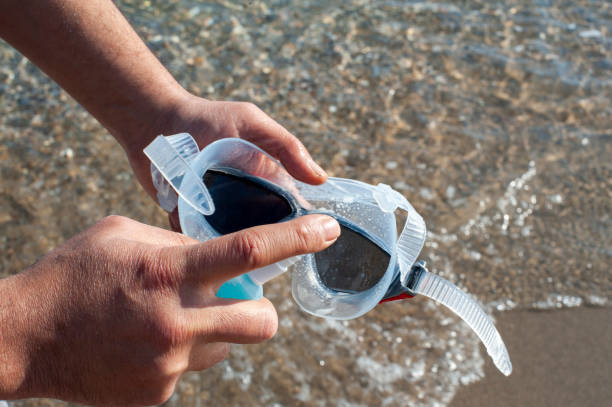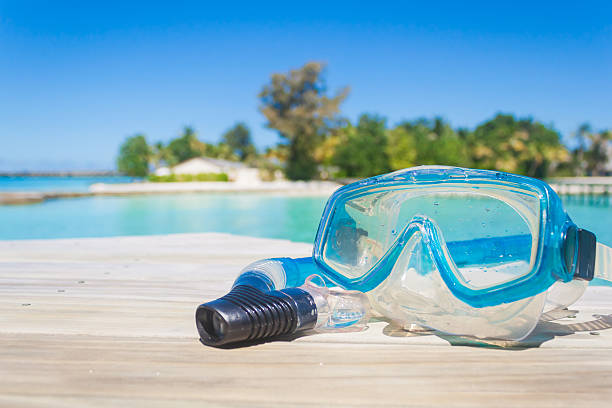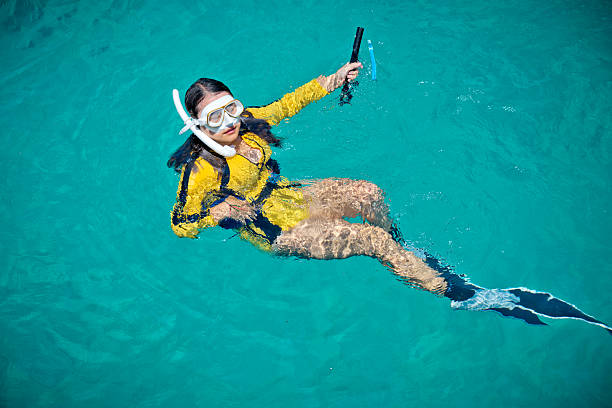Las máscaras de snorkel integrales han ganado popularidad, ofreciendo una atractiva combinación de comodidad y mayor visibilidad bajo el agua. A medida que crece su presencia en el mercado, aumentan también las preguntas sobre su seguridad. Este artículo profundiza en la seguridad de las máscaras de snorkel integrales y sus intrincados detalles, con el objetivo de desentrañar sus características y posibles riesgos, a la vez que ofrece una guía completa para los aficionados al snorkel.
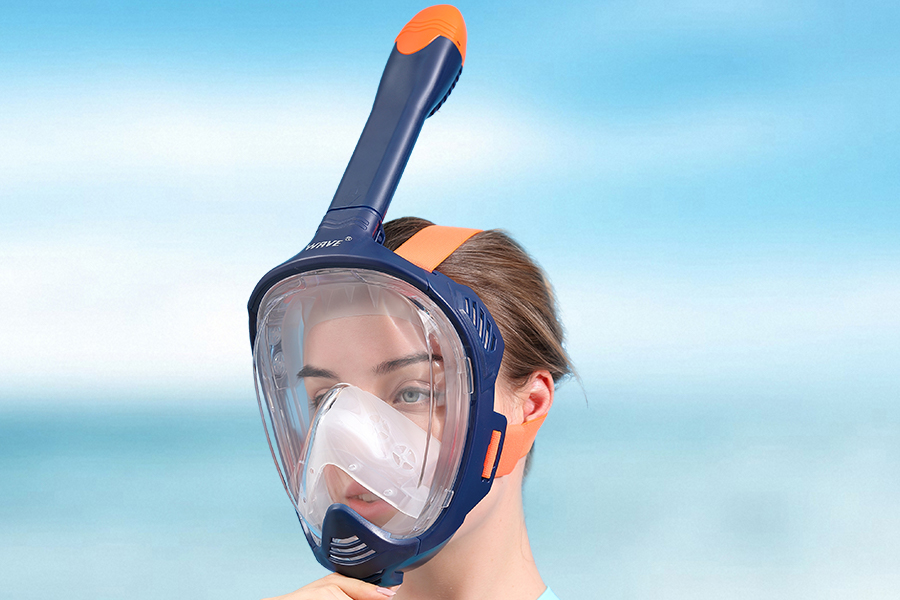
¿Podemos usar máscaras de snorkel integrales? La respuesta es sí, y por eso.
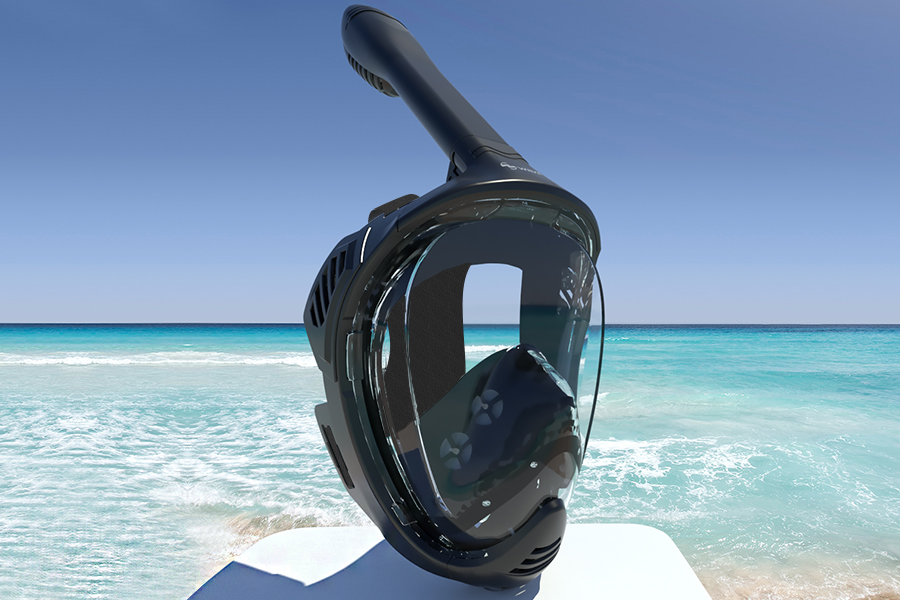
Máscaras de snorkel de cara completa Representan un avance significativo respecto a las máscaras y esnórqueles tradicionales. Están diseñados para cubrir todo el rostro, integrando el tubo de respiración en la propia máscara. Este diseño permite a los usuarios respirar naturalmente por la nariz y la boca, ofreciendo una experiencia más cómoda y menos claustrofóbica.
A diferencia de los equipos de snorkel tradicionales, donde la máscara y el snorkel están separados, las máscaras faciales completas combinan ambos, lo que elimina la necesidad de sujetar la boquilla del snorkel entre los dientes.
Además, van más allá de la comodidad. Ofrecen una vista panorámica, lo que mejora la experiencia subacuática al permitir a los buceadores ver más del entorno sin girar la cabeza. Estas máscaras suelen incluir sistemas de tapa seca integrados, que impiden la entrada de agua al tubo al sumergirse. Las máscaras tradicionales, en cambio, suelen requerir que los usuarios dominen la técnica de vaciado del agua. Las máscaras integrales simplifican este proceso, lo que las hace especialmente atractivas para principiantes.
Problemas de seguridad comunes que preocupan a la gente
A pesar de sus múltiples beneficios, las máscaras de snorkel integrales han suscitado inquietudes sobre su seguridad tanto entre usuarios como entre expertos. Comprender estas cuestiones es crucial para tomar una decisión informada.
Riesgo de acumulación de CO2
Una de las principales preocupaciones con las máscaras de snorkel de cara completa es el riesgo de acumulación de dióxido de carbono (CO2). El diseño de estas máscaras puede crear bolsas donde el CO2 exhalado persiste, provocando su reinhalación. Esto puede causar síntomas como mareos, desorientación y, en casos extremos, pérdida del conocimiento. Para mitigar este riesgo, los fabricantes han estado innovando en sistemas de ventilación que promueven una circulación de aire eficiente. Asegurarse de que la máscara cuente con canales de ventilación adecuados y usarla según las instrucciones es fundamental para minimizar este peligro.
Posibilidad de dificultades respiratorias
Respirar naturalmente por la nariz y la boca puede ser un arma de doble filo. Si bien ofrece comodidad, también puede causar dificultades respiratorias si la máscara no está diseñada correctamente. Las máscaras mal diseñadas pueden generar resistencia, lo que dificulta inhalar y exhalar con fluidez. Se recomienda buscar máscaras con sistemas de flujo de aire eficientes y probar diferentes modelos para encontrar el que mejor se adapte. También se recomiendan descansos regulares y no esforzarse demasiado al bucear para prevenir problemas respiratorios.
Problemas de visibilidad y campo de visión
Otra preocupación es la visibilidad. Si bien las máscaras faciales completas ofrecen una vista panorámica, su diseño a veces puede provocar empañamiento, lo que dificulta el campo de visión. Las máscaras de alta calidad suelen incluir recubrimientos o sistemas antivaho para solucionar este problema. Los usuarios también pueden aplicar soluciones antivaho o asegurarse de limpiarlas correctamente antes de usarlas. Asegurarse de que la máscara se ajuste bien también ayuda a mantener una visibilidad clara.
¿Cómo evaluar correctamente sus características de seguridad?
Evaluar las características de seguridad de una máscara de snorkel de cara completa es esencial para garantizar una experiencia de snorkel segura y placentera.
Evaluar el diseño antifugas
Un diseño antifugas confiable es crucial para una experiencia de snorkel cómoda y segura. Al evaluar una máscara, priorice las que tienen faldones de silicona de alta calidad, ya que brindan un ajuste flexible y cómodo al rostro, previniendo eficazmente las fugas. Verifique que el bolsillo nasal esté bien diseñado, lo que facilita la compensación y garantiza un buen sellado. Las correas ajustables también son importantes para asegurar que la máscara se ajuste firmemente sin apretar demasiado. Antes de adentrarse en aguas más profundas, pruebe la máscara en zonas poco profundas para verificar que mantenga un sellado hermético y no se empañe fácilmente. Este enfoque proactivo garantiza una aventura de snorkel más placentera y sin problemas.
Evaluar el sistema integrado de techo seco
El sistema de tapa seca integrado es otra característica de seguridad crucial. Este mecanismo impide la entrada de agua en el tubo del snorkel cuando está sumergido, lo que reduce el riesgo de inhalación. Compruebe que el sistema de tapa seca funcione correctamente y se selle automáticamente cuando el snorkel esté sumergido.
Evaluar la cobertura y protección facial completa
La cobertura facial completa proporciona protección integral, protegiendo el rostro del agua y permitiendo una respiración sin obstáculos. Sin embargo, es fundamental asegurarse de que la máscara no presione demasiado el rostro, ya que esto puede causar molestias y dificultar la respiración. La máscara debe quedar cómoda, sin puntos de presión.
Investigaciones y estudios reales sobre seguridad
Los estudios científicos brindan información valiosa sobre la seguridad de las máscaras de snorkel de cara completa y orientan a los consumidores hacia opciones más seguras.
Análisis de los resultados y hallazgos de las pruebas
Estudios recientes han probado varios modelos de máscaras de snorkel de cara completa, centrándose en factores como la acumulación de CO2, la resistencia al flujo de aire y la seguridad general.
En un estudio exhaustivo realizado por DAN (Divers Alert Network), investigadores analizaron varias máscaras de snorkel de diferentes fabricantes. El estudio reveló que algunos modelos presentaban niveles de retención de CO2 significativamente superiores a los de las máscaras y snorkels tradicionales. Por ejemplo, una máscara probada mostró niveles de CO2 de hasta 4,51 TP³T, mientras que el umbral de seguridad aceptable para la retención de CO2 suele ser inferior a 11 TP³T. Los niveles altos de CO2 pueden provocar hipercapnia, que causa síntomas como mareos, dolores de cabeza y, en casos graves, pérdida del conocimiento.
Otro estudio realizado por Consumer Reports, en colaboración con un laboratorio de pruebas europeo, examinó la resistencia al flujo de aire en varias máscaras de snorkel de cara completa. Los resultados indicaron que, si bien muchas máscaras proporcionaban una ventilación adecuada, algunos modelos presentaban un flujo de aire deficiente, lo que dificultaba la respiración y aumentaba el riesgo de incomodidad o pánico bajo el agua. Por ejemplo, se descubrió que un modelo de máscara en particular tenía una resistencia al flujo de aire 35% superior a la de los equipos de snorkel tradicionales, lo que puede causar dificultades respiratorias, especialmente durante la natación intensa.
Estos hallazgos subrayan la importancia de elegir mascarillas de fabricantes de renombre que cumplan con estrictos estándares de seguridad. Modelos de marcas reconocidas como VanguardiaTribord, Ocean Reef y Seaview obtuvieron un rendimiento significativamente mejor en cuanto a niveles de CO2 y eficiencia del flujo de aire en comparación con alternativas más económicas sin marca. La máscara Tribord Easybreath, por ejemplo, mostró niveles de retención de CO2 consistentemente inferiores a 0,71 TP3T, dentro de los límites de seguridad, y presentó una resistencia mínima al flujo de aire.
Opiniones y recomendaciones de expertos
Expertos en buceo y snorkel han opinado sobre la seguridad de las máscaras de snorkel integrales. Muchos recomiendan optar por máscaras que hayan superado rigurosas pruebas y certificaciones. El Dr. Neal W. Pollock, director de investigación de DAN, aconseja a quienes practican snorkel que tengan cuidado con las máscaras genéricas y sin probar que suelen venderse en línea. Destaca la importancia de comprar máscaras con certificaciones de seguridad claras, como el marcado CE, que indica el cumplimiento de las normas europeas de salud, seguridad y protección ambiental.
Además, los expertos recomiendan descansos frecuentes al practicar snorkel para evitar el sobreesfuerzo y la posible acumulación de CO2. También enfatizan la necesidad de un mantenimiento adecuado y una inspección regular de las máscaras para garantizar su correcto funcionamiento. Medidas sencillas como limpiar la máscara después de cada uso y comprobar si presenta signos de desgaste o daños pueden mejorar significativamente la seguridad.
Experiencias y testimonios de usuarios sobre máscaras de snorkel integrales
Los comentarios de los usuarios aportan información valiosa sobre el rendimiento y la seguridad de las máscaras de snorkel integrales. Analicemos algunos ejemplos reales en diferentes aspectos de la experiencia de usuario.
Comentarios positivos de los usuarios
Muchos usuarios han compartido experiencias positivas con las máscaras de snorkel de cara completa, destacando su comodidad, conveniencia y mejor visibilidad bajo el agua.
Aspecto positivo: Comodidad y facilidad para respirar.
Llevo más de un año usando la máscara Seaview 180° y ha transformado por completo mi experiencia de snorkel. Se ajusta perfectamente y es increíblemente cómoda. Respirar por la nariz y la boca se siente completamente natural, y me encanta no tener que preocuparme nunca de que entre agua en el tubo. ¡Ha hecho que el snorkel sea mucho más placentero! – Alex, un apasionado del snorkel de Hawái
Aspecto positivo: Vista panorámica
Hace poco probé la máscara Ocean Reef Aria durante una excursión de snorkel en el Caribe y me impresionó la vista panorámica que me brindó. La lente nítida y amplia me permitió ver mucho más bajo el agua y me sentí como si fuera parte del océano. ¡Es, sin duda, la mejor máscara que he usado! – Sarah, una apasionada del océano de Florida
Quejas y problemas comunes reportados
Si bien las máscaras de snorkel de cara completa han recibido elogios de muchos usuarios, también hay quejas y problemas comunes informados por algunos usuarios.
Problema reportado: empañamiento
Compré una máscara de snorkel completa de una marca poco conocida con la esperanza de disfrutar de una experiencia de snorkel cómoda y agradable. Sin embargo, me decepcionó descubrir que se empañaba constantemente, lo que me impedía ver y arruinaba la experiencia. A pesar de probar soluciones antivaho, el problema persistió y terminé volviendo a mi máscara tradicional. – Mark, un buceador frustrado de California
Problema reportado: Fugas
Probé la máscara Tribord Easybreath durante una excursión de snorkel en México y, aunque me encantó su comodidad y su amplio campo de visión, experimenté una fuga considerable alrededor del sello. Por mucho que ajustara las correas, el agua se filtraba en la máscara, causando interrupciones constantes e incomodidad. Fue una experiencia decepcionante, sobre todo considerando las reseñas positivas que había leído. – Jessica, entusiasta del snorkel de Texas
Incidentes y accidentes de la vida real
Si bien son poco frecuentes, se han dado casos de incidentes y accidentes reales asociados con máscaras de snorkel de cara completa, lo que resalta la importancia de las precauciones de seguridad y el uso adecuado.
Incidente: acumulación de CO2
Durante una excursión de snorkel en las Bahamas, comencé a sentirme mareado y desorientado mientras usaba una máscara de snorkel completa. Al principio lo atribuí al esfuerzo, pero al regresar a la superficie, me di cuenta de que estaba experimentando síntomas de acumulación de CO2. Fue una experiencia aterradora, así que me quité la máscara rápidamente y busqué atención médica. Desde entonces, he sido más cauteloso y selectivo con las máscaras que uso. – David, buceador experimentado de Nueva York
Incidente: Mal funcionamiento de la máscara
Mientras practicaba snorkel en Tailandia, mi amiga tuvo un incidente aterrador con su máscara. De repente, el sistema de secado de la máscara falló, lo que permitió que entrara agua en el tubo. Presa del pánico y sin poder respirar, se quitó rápidamente la máscara y salió a la superficie. Afortunadamente, salió ilesa, pero fue un duro recordatorio de la importancia de la fiabilidad y la seguridad del equipo. – Rachel, viajera aventurera de Australia
Estos ejemplos de la vida real subrayan la necesidad de una evaluación exhaustiva y de tener precaución al usar máscaras de snorkel de cara completa. Si bien ofrecen muchas ventajas, es fundamental que los usuarios sean conscientes de los posibles problemas y prioricen la seguridad en todo momento.
Consejos para hacer snorkel de forma segura con máscaras faciales completas
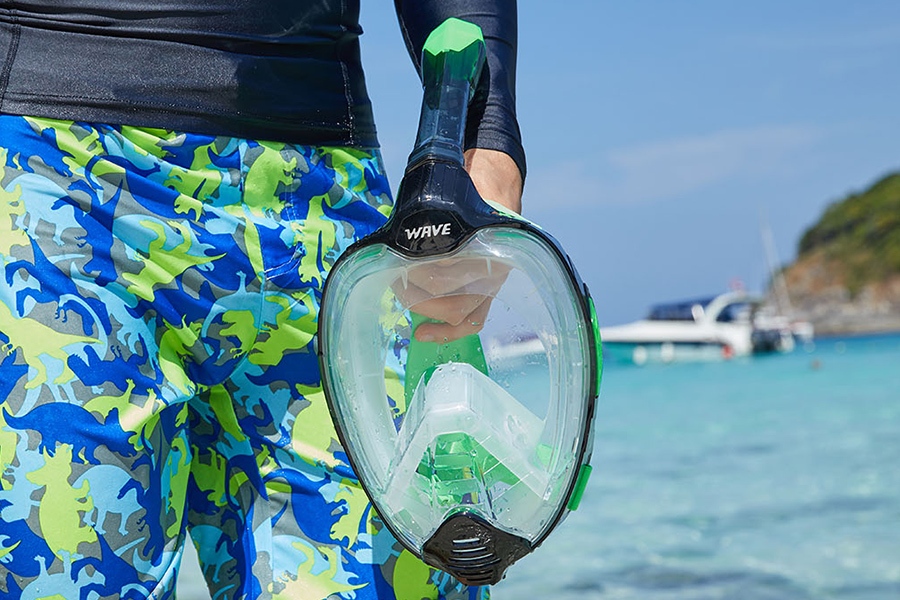
Una experiencia de snorkel segura con máscaras completas requiere una preparación adecuada y el cumplimiento de las buenas prácticas. Siguiendo las instrucciones correctas, podrá maximizar la seguridad y el disfrute mientras explora las maravillas del mundo submarino con su máscara de snorkel completa. Exploremos algunos consejos esenciales sobre diferentes aspectos.
Ajuste y colocación adecuados
Antes de meterse al agua, ajuste las correas de la máscara para que queden bien ajustadas y seguras. Asegúrese de que la máscara se ajuste cómodamente a su cara sin dejar puntos de presión ni huecos. Una máscara bien ajustada crea un sello hermético, evitando fugas y minimizando el riesgo de que entre agua en el tubo de snorkel.
Consejos para evitar problemas comunes
Para evitar que se empañe, aplique una fina capa de solución antivaho en el interior de la lente de la máscara antes de cada uso. Además, asegúrese de que la máscara esté limpia y seca antes de aplicar la solución para una eficacia óptima. Seguir estos sencillos pasos le ayudará a mantener una visibilidad clara bajo el agua y a mejorar su experiencia de snorkel.
Mejores prácticas para principiantes
Comienza tu experiencia de snorkel en aguas poco profundas y tranquilas, donde podrás practicar el uso de la máscara y el tubo en un entorno controlado. Respira lenta y pausadamente y concéntrate en mantener una postura relajada y cómoda en el agua. Aumenta gradualmente la profundidad y explora nuevos lugares a medida que adquieres confianza y dominio de las técnicas de snorkel.
¿Cómo mejorar la seguridad? Directrices e instrucciones del fabricante
Los fabricantes proporcionan directrices e instrucciones esenciales para mejorar la seguridad de las máscaras de snorkel integrales. Analicemos diversos aspectos y detalles concretos para garantizar un uso seguro.
Instrucciones de uso adecuadas
Los fabricantes suelen recomendar familiarizarse con las características y funciones de la máscara antes de usarla. Esto incluye comprender cómo ajustar las correas para un ajuste seguro, cómo vaciar la máscara en caso de entrada de agua y cómo usar funciones adicionales como el sistema de parte superior seca. Además, se recomienda a los usuarios practicar la respiración a través de la máscara en un entorno controlado antes de adentrarse en aguas más profundas.
Nota*: Asegúrese de leer y comprender atentamente el manual de usuario proporcionado por el fabricante. Preste especial atención a las instrucciones o precauciones específicas, como los límites de profundidad recomendados o los rangos de temperatura del agua, para evitar posibles riesgos o daños a la máscara.
Consejos de mantenimiento y limpieza
Los fabricantes suelen recomendar enjuagar la mascarilla con agua dulce después de cada uso para eliminar la sal, la arena y otros residuos que puedan acumularse. También es importante secarla bien antes de guardarla en un lugar fresco y seco, alejado de la luz solar directa. Además, algunas mascarillas pueden requerir una limpieza periódica con agua y jabón suave para eliminar cualquier residuo o acumulación.
Nota*: Evite usar productos químicos agresivos o limpiadores abrasivos, ya que pueden dañar los materiales de la mascarilla y afectar su integridad. Siga atentamente las instrucciones de limpieza del fabricante para conservar la calidad y funcionalidad de la mascarilla a lo largo del tiempo.
Advertencias y recomendaciones de seguridad del fabricante
Las advertencias de seguridad comunes pueden incluir recordatorios de no practicar snorkel solo, de mantenerse dentro de los límites de profundidad recomendados y de evitar movimientos bruscos o actividades extenuantes con la máscara puesta. Los fabricantes también pueden ofrecer recomendaciones para inspeccionar la máscara en busca de signos de desgaste o daños antes de cada uso, así como orientación sobre cuándo reemplazar ciertos componentes, como las juntas o correas de silicona.
Nota*: Tome en serio las advertencias de seguridad del fabricante e incorpórelas en sus prácticas de snorkel para minimizar el riesgo de accidentes o lesiones. Priorice la seguridad en todo momento y tenga precaución al usar su máscara facial completa en condiciones desconocidas o difíciles.
Normas regulatorias y certificaciones
Fabricantes de renombre como Vanguard suelen someter sus máscaras de snorkel integrales a rigurosos procesos de prueba y certificación para garantizar que cumplen o superan los estándares de seguridad establecidos. Busque certificaciones como el marcado CE, que indica el cumplimiento de las normas europeas de salud, seguridad y protección del medio ambiente. Además, algunos fabricantes pueden someterse voluntariamente a pruebas realizadas por organizaciones independientes u organismos reguladores para validar la seguridad y el rendimiento de sus máscaras.
Conclusión
En conclusión, la pregunta "¿Qué tan seguras son las máscaras de snorkel de cara completa?" requiere una consideración cuidadosa, pero pueden ofrecer una experiencia de snorkel segura y placentera con un uso y mantenimiento adecuados, y el cumplimiento de las instrucciones del fabricante. Siguiendo las mejores prácticas, como asegurar un ajuste correcto, un mantenimiento regular y prestar atención a las advertencias de seguridad, quienes practican snorkel pueden mitigar los posibles riesgos y maximizar los beneficios de estas innovadoras máscaras. Si bien existen inquietudes, una toma de decisiones informada, junto con máscaras confiables de fabricantes reconocidos, puede mejorar significativamente los niveles de seguridad. En definitiva, con vigilancia y un uso responsable, las máscaras de snorkel de cara completa pueden brindar una puerta de entrada segura a las maravillas del mundo submarino.
Preguntas frecuentes
P1: ¿Cuánto tiempo puedes respirar con una máscara de snorkel de cara completa?
En promedio, los usuarios pueden respirar cómodamente con una máscara de snorkel completa durante aproximadamente 1 a 2 horas, con una actividad de snorkel normal y un esfuerzo moderado. Sin embargo, factores individuales como la capacidad pulmonar y la condición física pueden influir en esta duración.
P2: ¿Cómo sumergirse en el agua con una máscara de snorkel de cara completa?
Para sumergirse con una máscara de snorkel completa, simplemente respire hondo, contenga la respiración y sumérjase bajo la superficie del agua. Asegúrese de que la máscara esté bien ajustada a su cara para evitar la entrada de agua. Una vez bajo el agua, exhale suavemente por la nariz para equilibrar la presión y disfrutar del paisaje submarino.
P3: ¿Los snorkels de cara completa son buenos para los niños?
Las máscaras de snorkel integrales pueden ser adecuadas para niños, pero se deben considerar varios factores antes de permitirles usarlas. El tamaño y las características adecuados garantizan un ajuste perfecto y una experiencia de uso cómoda. Además, se debe supervisar de cerca a los niños mientras usan máscaras de snorkel integrales, especialmente si son nadadores sin experiencia o principiantes en el snorkel. Los padres también deben asegurarse de que sus hijos comprendan cómo usar la máscara correctamente, incluyendo cómo vaciar el agua del snorkel y de la superficie si es necesario.
P4: ¿Son los snorkels de cara completa realmente mejores que las máscaras tradicionales?
La mejoría de las máscaras de snorkel integrales respecto a las tradicionales depende de las preferencias y necesidades individuales. Las máscaras integrales ofrecen un campo de visión más amplio, facilitan la respiración por la nariz y la boca, y pueden resultar más cómodas para algunos usuarios. Sin embargo, las máscaras tradicionales ofrecen mayor flexibilidad, suelen ser más compactas para viajar y facilitan la evacuación del agua del snorkel. En definitiva, la elección entre ambas depende de factores como la comodidad, la facilidad de uso y las preferencias personales.
P5: ¿Las máscaras de snorkel de cara completa plantean problemas de seguridad?
Sí, las máscaras de snorkel de cara completa pueden plantear problemas de seguridad, especialmente en cuanto a la acumulación de CO2, dificultades respiratorias y posibles fugas. Las máscaras mal ajustadas o con sistemas de ventilación inadecuados pueden presentar riesgos como la retención de CO2, que puede provocar mareos o pérdida del conocimiento. Además, los usuarios pueden experimentar dificultades respiratorias si la máscara restringe el flujo de aire. El uso correcto, el cumplimiento de las instrucciones del fabricante y la selección de máscaras de alta calidad pueden ayudar a mitigar estos problemas.
P6: ¿Las máscaras de snorkel de cara completa tienen fugas?
Las máscaras de snorkel de cara completa pueden tener fugas si no se ajustan correctamente o si los sellos de los bordes están dañados. Sin embargo, las máscaras de alta calidad con mecanismos de sellado eficaces están diseñadas para minimizar las fugas. Es fundamental asegurarse de que la máscara esté correctamente ajustada a la cara y que las correas estén bien apretadas para evitar la entrada de agua. El mantenimiento y la inspección regulares de los sellos de la máscara también pueden ayudar a prevenir fugas durante las sesiones de snorkel.
P7: ¿Por qué no se pueden usar máscaras de snorkel en las piscinas?
Las máscaras de snorkel no suelen recomendarse para su uso en piscinas, ya que su diseño, en particular el tubo, está pensado para entornos de aguas abiertas como océanos, lagos o ríos. En una piscina, el tubo podría no funcionar eficazmente debido a la falta de olas o corrientes que generen un flujo de aire natural. Además, el diseño de la máscara puede dificultar la técnica de natación, dificultando la navegación y aumentando el riesgo de accidentes o colisiones con otros nadadores.
